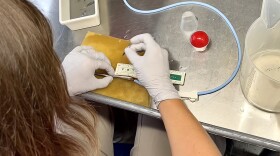-
Almost all of the wheat grown in the Pacific Northwest is for export, and even before President Trump's trade war, farmers were dealing with rock bottom prices and slagging global demand.
-
The U.S. government recently recognized the harm caused by the dams and has promised to work to restore salmon runs but tribal members doubt much will change.
-
As salmon and steelhead swim upstream, they’re now facing one more challenge in fish ladders. It’s a non-native fish competing for space: the American shad.
-
It’s the same type of algae that turned up on the Snake River last year. In high concentrations, it harms people, pets, and livestock. The toxins can also accumulate in fish.
-
On the banks of the Snake River in far eastern Washington, sockeye salmon have had a rough summer. The water behind the last major concrete dam they have to swim past is way too hot.
-
The shellfish can encrust dam infrastructure and clog water pipes, and threaten to cause millions of dollars worth of problems.
-
A conservation group is helping people see a different perspective of the Snake River dams in southeastern Washington.
-
A harmful algal bloom on the Snake River has spanned nearly 30 miles of the river. The Whitman County health department says it hasn’t seen a bloom like this on the Snake before.
-
Scientists at Pacific Northwest National Laboratory are tagging and releasing lamprey to learn more about their journey to sea from inland rivers.
-
As the mercury climbs this weekend, water temperatures are also expected to increase. Warmer waters can spell bad news for salmon, especially if the…
Play Live Radio
Next Up:
0:00
0:00
Available On Air Stations










